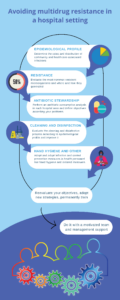Highlights
-
Determining infection and multidrug resistance (MDR) rates continuously helps to detect the problem to be solved, including outbreaks.
-
Cleaning and disinfection play an important role in preventing MDR and evaluating and correcting the process for better results.
-
MDR control can only be achieved with various measures applied continuously and consistently by a group of committed individuals.
Development
Antimicrobial resistance is a global crisis. Approximately 1.3 million deaths were directly attributable to multidrug-resistant (MDR) microorganisms in 2019.1 These infections also have significant implications for hospital control and expenditure, as well as morbidity and mortality.2,3 MDR microorganisms can colonize a patient for months or years, and this colonized population can re-enter the community and potentially transmit this resistance.4,5
Controlling MDR in hospitals is crucial not only for reducing morbidity and mortality in hospitalized patients, but also for ensuring the quality of healthcare and reducing hospital costs.6
This task is challenging and involves multiple activities implemented simultaneously after a local epidemiological analysis, along with evaluating and providing feedback on the measures taken to identify the strengths and weaknesses of each hospital environment. These activities include the following:
-
evaluating the epidemiological profile of community- and healthcare-associated infections (HAIs);
-
assessing the hospital resistance profile;
-
analysing antibiotic consumption;
-
evaluating cleaning and disinfection processes:
-
promoting hand hygiene; and
-
implementing other measures.
Point 1: Evaluating the epidemiological profile of community- and healthcare-associated infections
This includes identifying the infections, causative microorganisms and susceptibility profiles reported as a value, for example, #/1,000 catheter days and #/1,000 ventilator days, which are evaluated over a specific period and are globally comparable.7,8 The reported frequency of MDR in HAIs varies between 25.4% and 42.5%, and these percentages vary in each hospital.9–11 Analysing the rates of infections and the frequency of MDR microorganisms and whether empirical antimicrobial use is appropriate in HAIs benefit the problem detection, including outbreaks. These data must be collected, evaluated and communicated continuously because it is the key to management decision-making.
Point 2: Assessing the hospital resistance profile
This involves identifying the most frequent MDR microorganisms and their distribution. In 2017, the World Health Organization published a list of critical priority pathogens. The most significant in hospitals include methicillin-resistant Staphylococcus aureus, vancomycin-resistant enterococci, extended-spectrum beta-lactamase (ESBL) Enterobacteriaceae, Enterobacterales, Clostridioides difficile (CD), carbapenem-resistant Acinetobacter baumannii, Pseudomonas aeruginosa and Enterobacteriaceae.2,12 The distribution of MDR microorganisms varies in each hospital, region and continent.13,14 Identifying the most common MDR microorganisms in a hospital, the areas where they arise and their behaviour over time helps focus efforts on areas needing surveillance and control.
Point 3: Analysing antibiotic consumption
This includes evaluating antibiotic consumption with recommended measures.15,16 These data and the epidemiological profile help determine if there are alarming antibiotic consumption patterns, such as frequent carbapenem use in an intensive care unit, with only 3% ESBL isolates. Antimicrobial stewardship includes electronic pre-authorization systems or personnel providing feedback after prescriptions; this can encompass all or some antimicrobials and all or certain hospital areas. Involving each department’s staff in decision-making, protocol development and educational measures on prescribing is essential to achieving the main programme goal: changing antibiotic prescribing behaviour.15,17
Biochemist pharmacists should be included to report inappropriate antibiotic use and potentially lead the antimicrobial stewardship programme.18–20 The microbiology laboratory should standardize culture reports to guide physicians towards appropriate treatment decisions.21–23 Initially, programme goals should be defined, such as reducing CD rates or glycopeptide consumption, and compliance should be re-evaluated.
All available tools should be used to control antibiotics in the hospital through various interventions to improve antibiotic prescriptions.
Point 4: Evaluating the cleaning and disinfection process
None of the previous points will be effective without environmental control. Microorganisms can live on surfaces for weeks or months, potentially causing infections in hospitalized patients through horizontal transmission.24,25 Studies have shown that the risk of acquiring an MDR microorganism in a room previously occupied by a colonized patient is up to four times higher.26–28 Different cleaning and disinfection interventions have controlled MDR microorganism outbreaks, highlighting the importance of this process (see Table 1).29–33
Table 1: Outbreaks with different control and prevention interventions29–33
| Study | Problem | Intervention in cleaning and disinfection | Other interventions | Main outcome |
| Ikeda et al.29 | Outbreak of ESBL-producing bacteria in catheter-associated urinary tract infection in patients with spinal cord injury | Cleaning procedures were reviewed and the number of routine cleanings was increased using a complex-type chlorine-based disinfectant cleaner with potassium peroxymonosulphate | Environmental cultures once a week. Periodical surveillance of urine cultures for patients who have undergone catheterization. Nurses working in wards were educated on infection control, contact precautions and hand hygiene | Reduction to one ESBL-producing strain 1 month later |
| Zhu et al.30 | Thirty-one patients with Klebsiella pneumoniae carbapenemase-2 and/or New Delhi Metallo-β-Lactamase 1 K. pneumoniae strains in 10 different wards in a 2,076-bed tertiary care teaching hospital | Antimicrobial stewardship workers enhanced disinfection of the patient’s room at least three times a day; after discharge, the surroundings were cleaned in depth using a 500-ppm chlorine solution and high-touch surfaces were emphasized by the hospital hygiene nurse manager for cleaning to reduce cross-transmission | Set up a working group on the antimicrobial stewardship. Strict infection control procedures were put in place, including rapid communication, suggestions on rational drug use in time and training courses, contact precautions of carriers, surveillance cultures of the hand and environment and screening for all contact patients | Return to the epidemiological stage with sporadic occurrence of carbapenem-resistant K. pneumoniae strains |
| Gavaldá et al.31 | Increase in new cases of extensively drug-resistant (XDR) Acinetobacter baumannii after a period of high endemicity | To agree on the specific responsibilities and allocation of cleaning duties of the auxiliary nurses and housekeepers; deep environmental cleaning after a staggered schedule; increasing the cleaning frequency of high-touch surfaces; apply ready-to-use disinfectant wipes with cationic surfactant tensioactives, quaternary ammonium compounds and polymeric biguanide by auxiliary nurses and microfibre cleaning system containing 0.1% chlorine solution by housekeepers with the one-room, one-wipe approach | A multidisciplinary task force was established to determine the main control strategies; rectal swabs from patients admitted to the intensive care units | The implementation of interventions was associated with a significant change in the level of -8,360 XDR A. baumannii-infected patients per 1,000 patient days |
| Grabsch et al.32 | Markedly increased colonized patients on active screening of ‘high-risk’ wards (intensive care unit and renal, liver transplant and haematology-oncology units) and VRE bacteraemia | Replacement of surface cleaning/disinfection compounds with sodium hypochlorite 1,000 ppm + detergent; employment of cleaning supervisors and establishment of a formal training programme for cleaning staff; implementation of a thrice-annual schedule detailed bleach-based ‘super-clean-disinfection’ | Adherence to the Centers for Disease Control and Prevention VRE guidelines for managing patients with colonization | Significant reductions in newly recognized colonized VRE (208/1,948 patients screened versus 324/4,035, a 24.8% reduction); the total burden of inpatients with VRE declined; median percentage of colonized inpatients per week: 19.4% versus 17.3%; hospital-wide VRE bacteraemia declined 83.1% |
| Salazar et al.33 | Increase in CRE strains in a general hospital | Training to cleaning and disinfection staff twice a year; monthly supervisions of the cleaning and disinfection process with a checklist, reviewing for the cleanliness of surfaces with alcohol wipes, and analysed the processes | Full management support for all decisions related to infection control; blinded observation of hand hygiene with monthly evaluations, disseminating the data to sensitize health personnel; restrictive antimicrobial stewardship; active surveillance of healthcare infections and contact isolation of carries in a specific area | Decrease in the CRE rate: 0.59 versus 0.18 cases/1,000 patient days |
CRE = carbapenem-resistant Enterobacteriaceae; ESBL = extended-spectrum beta-lactamase; VRE = vancomycin-resistant enterococci; XDR = extensively drug-resistant.
First, the process should be observed: how it is conducted and if basic principles and recommended frequencies are applied with correct materials and dilutions.34,35 Disinfectants should meet international standards, and selection should be based on local epidemiology.28,30 Possible barriers, such as toxicity data, difficult dilutions, application methods and communication challenges that limit process compliance, should also be evaluated.36,37 For well-resourced institutions, non-touch technologies are advantageous.38–40 However, hospitals with fewer resources must consider human and material limitations. Frequent supervision of the process is also crucial: both observational and objective with methods, such as adenosine triphosphate bioluminescence, along with feedback and periodic update training.36,41,42
Point 5: Promoting hand hygiene
The importance of adherence to hand hygiene in infection control is undeniable.43–45 Every hospital should monitor hand hygiene adherence, disseminate these data and promote it. There is electronic technology that monitors product use and/or free electronic tools that consolidate hand hygiene observation data.46,47
Point 6: Other measures
In certain contexts, the contact isolation of patients colonized or infected with MDR microorganisms is questionable, but it remains a recommended measure by the Centers for Disease Control and Prevention.48–50 Contact isolation should be applied according to the epidemiological profile and hospital resources, educating staff on the use of personal protective equipment.
Other measures influencing MDR identification include protocols for detecting colonized patients, the use of skin-decolonizing agents and the emergence and study of outbreaks.51 Equally important is having sufficient, permanent and trained staff for patient care, especially in critical areas, to prevent horizontal transmission, as well as infrastructure that allows individual patient rooms in some hospitals versus shared spaces where contamination is more likely.52–54
Although the importance of MDR control is globally recognized, not all countries have mandatory regulatory standards for hospital control. It is essential to know local regulations that support infection control interventions and request financial, human and technological support from executive directive management, considering cost–benefit and savings analyses.55–57
Conclusion
MDR is a global threat, and its control is vital in hospitals. This control must be achieved through multiple measures (stewardship programme, improved cleaning and disinfection, adherence to hand hygiene, contact isolation and detection of colonized patients, among others) adopted after an epidemiological analysis that identifies frequent microorganisms and infections in hospital and through a working group that includes every actor from executive directive management to cleaning and disinfection staff, all fulfilling defined roles in evaluating, educating and continuously providing feedback on all MDR control processes in the hospital.




